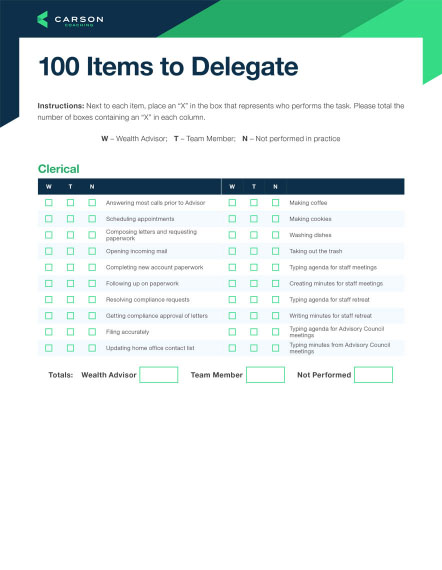Your team is the most important thing when it comes to delivering a solid client experience.
You can have the best tech in the world, but when it comes to providing the ideal client experience, you’ll need to rely on your team to do that.
You’re likely not starting your team from scratch. But you can always use new tools to build the team that is ideal for your practice.
There are many options to consider, like what type of structure you want to implement in your firm; whether you want to hire someone with a book of business, which might be more expensive; or how you can hire and retain the right people for the right roles.
Let’s get into the framework for building the most effective team for your firm.
Establish the Baseline and Identify Where You Want to Go
The best place to start in building the right team is to examine what your baseline is today. If you do have team members, what do those roles and responsibilities look like today? Is there potential for your team members to have a career path within your firm?
Then, you want to examine where you want to be. This is a good opportunity to revisit Blueprinting to define what your goals are for the next five to 10 years.
Third, you should also define your client experience and explore whether you want it to be different in the next five to 10 years.
Lastly, take all that information and use it to define your organizational structure, how many people you need on your team and in what seats you need them.
Determine Your Organizational Structure
There are many common organizational structures in how you organize your advisors in your firm. You can find the one that fits the best for you.
Here are some common ones:
Senior and associate structure. In this structure, when a senior advisor reaches capacity, they bring on a servicing wealth advisor to handle less-complex clients and provide financial planning support for the senior advisor. This simple advisor team structure will help you reach your goals and grow your business.
The finder, minder, grinder. In this organizational structure, you have three main roles: the finders, who are the ones who find the business and engage in business development. The finders usually have the title senior wealth advisor or equivalent. The minders are the people who handle the relationships. The minders usually have the advisor title. And lastly, the grinders, who are the people in the background making everything work. The grinders usually have the planner title.
The Diamond structure. The Diamond structure is a series of little structures like baseball diamonds. In the Diamond team structure, introduced by Angie Herbers and Herbers and Company, a senior advisor takes the top and second-base spot, and the lead (or service advisors) take the first- and third-base spots. Then at the home plate spot sits an associate advisor to complete the team dynamic. This approach streamlines tasks and ensures clients receive top-tier service from a well-rounded team. Once the lead advisor has a new book of business, they break off and create another diamond. A firm can have multiple diamonds.
Carson Wealth model. The Carson Wealth model has a dedicated business development officer to provide top-notch service to its clients. Each advisory team is composed of a senior wealth advisor, two wealth advisors, a paraplanner and a relationship manager to efficiently manage clients’ wealth. Our centralized operations team and wealth enhancement group support all our advisor teams.
Drawing the Map
Mapping out starts by working backward to define the different hurdles your company needs to pass to get to the point of your next hire.
For example, you’ll want to start at year 10 to determine where you need to be by year five. Say to yourself, “In order to get to ‘x’ by year 10, we need to be at ‘y’ by year five.”
It’s difficult to do a whole 10-year plan, which is why I try to get my members to stick to a one-, three- or five-year plan before they get to the 10-year plan. I do this by way of phases. One example of a phased plan is to identify what is happening in the current year, who the partners are, who the team is and what are the next critical roles you might need to make.
Here is an example:
Current year: 2023-2024
Partner names:
Team/current roles:
- Operations and part-time support
- Executive assistant
- Marketing professional
- Financial advisor/planner
Firm size: Current firm value of assets and number of clients.
Next two critical roles:
- Client service associate/front office
- Relationship manager/financial planner
Phase 2 by 2025-2028
Partner names:
Team/desired roles by target date:
- Director of operations, one or two client service associates and front office/executive assistant
- Director of marketing, possible intern or part-time associate
- Lead financial advisor, one or two associate advisors, and one or two relationship managers/financial planners
Desired firm size by target year (whatever you deem this to be).
Critical decisions: Grow HR and compliance and other further business structures?
Phase 3 by 2028-2032
Partner names (by this target date, you could consider adding more partners or developing a track to partnership for your critical stakeholders):
Team/desired roles by target date:
- Director of operations: two to three client service associates, front office or executive assistant
- Director of marketing: Director of marketing and marketing intern or associate
- Lead financial advisors: Two financial advisors, two associates and two relationship managers/planners
Desired firm size by target year (whatever you deem this to be).
The obstacles you might face are unique to your firm, but there are some potential common problems you should look out for in drawing the map. Those might include:
Someone leaving your firm. What would it do to your firm, your plans and your growth if one of your stakeholders leaves? How might you overcome that? The key to being able to be agile in that situation is to always be meeting with current advisors and being open to new team members.
Budget changes. The market has shifted significantly in the past few years, and that might shift the funds you have available for new team members. Start saving now for hires down the road. Have at least three to six months of compensation for a position saved, because the return on an investment in a position won’t happen immediately.
Always Be Hiring and Keeping the Right Team
Building and cultivating your network is essential to implementing the always-be-hiring part of the framework. Your network is likely already pretty strong, but you can continue to build it through attending industry events (they’re back in full swing since last year) and connecting with association volunteer leaders.
Having the phases outlined in the previous section could help because if you come across someone who is fantastic for one of those aspirational positions, but you’re not ready to hire yet, you can identify what you need to do to get that person in there and adjust to put you on the path to getting there.
Another component of the framework is after bringing in the right team, you need to be able to keep the right team. Ensure you have great compensation structures, benefits packages and a solid culture.
Keep up to date on compensation trends and ensure you have career pathing for your team. Determine whether you will share equity and be clear about that from the beginning. To some people, equity is incredibly important, but others could not care less about equity.
Another critical aspect to retaining your team is that you continue to grow as a leader. Surround yourself in communities that will continue to make you stretch and grow so you’re not stagnant. Advisors are always looking for the next certification or designation, but where many really need help is in their leadership or team-building skills.
Getting involved in mastermind groups, hiring a coach and being part of communities like the Financial Planning Association are all ways you can develop those critical leadership skills. Sometimes when advisors reach a high level of success, they feel they “graduate” from going to conferences, but you always have the ability to learn something new at these events.
Also, ask for feedback from your team. Make sure you schedule time to meet with them and listen to their concerns.
Lastly, focus on scheduling solitude and time to focus on being a mindful leader.
Solid Team, Solid Client Experience
Having a solid team is the key to delivering an exceptional client experience. Taking the time to build the right team at your firm requires putting in the effort upfront to create a plan that will help you get from where you are to where you want to be.
With careful consideration, you can create a team that delivers the ideal client experience to your ideal clients.
By following the framework in this blog post, you might be able to construct a strong foundation on which your firm can build its success and ensure continued growth in the future.




